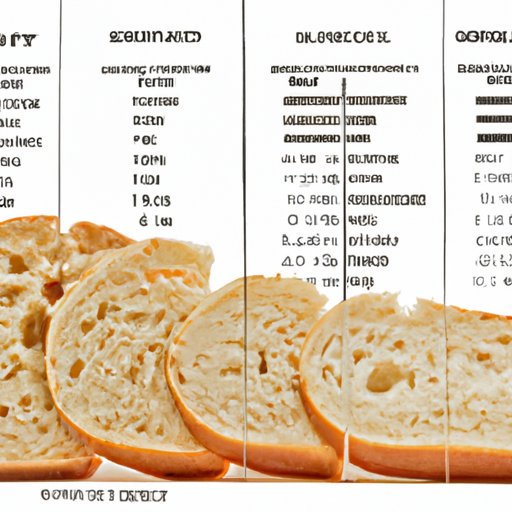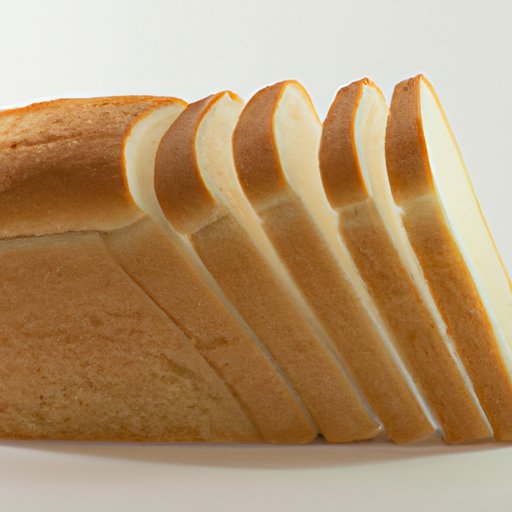Introduction
White bread is a staple food in many households around the world. It is made using flour that has been highly processed and refined, which removes most of its nutrients and fiber. While white bread is often seen as an unhealthy option due to its lack of nutritional value, there are some benefits associated with eating it.
What is White Bread?
White bread is a type of bread made from wheat flour that has been stripped of its bran and germ layers, leaving only the endosperm. This process results in a product that is light in color, soft in texture, and has a mild flavor. White bread is widely available in supermarkets and bakeries, and is often used for sandwiches, toast, and other foods.

Overview of the Nutritional Profile of White Bread
White bread is mostly composed of carbohydrates, with a small amount of protein and fat. It is low in vitamins and minerals, but does contain some B vitamins like thiamine, riboflavin, and niacin, as well as iron. White bread also contains a small amount of dietary fiber, usually around 1-2 grams per slice.
Pros and Cons of Eating White Bread
Nutritional Benefits of White Bread
Despite its nutrient-poor status, white bread still provides some nutritional benefits. As it is low in fat and calories, it can be a good choice for those trying to manage their weight. One study found that people who ate white bread as part of a reduced-calorie diet lost more weight than those who ate whole-grain breads. White bread also provides a small amount of B vitamins and iron, both of which are important for overall health.
Health Risks Associated with White Bread Consumption
Eating too much white bread can lead to health problems. Due to its lack of fiber, it can cause constipation and other digestive issues. Studies have also linked white bread consumption to a higher risk of obesity, type 2 diabetes, and heart disease. Additionally, white bread is considered a “processed” food, meaning that it lacks essential vitamins, minerals, and other beneficial compounds that are found in unprocessed foods.

Comparing White Bread to Other Types of Breads
Nutritional Differences Between White and Whole-Grain Breads
Whole-grain breads are a healthier alternative to white bread, as they contain more fiber and a wider range of vitamins and minerals. Whole-grain breads are made using flour that includes all of the grain’s components, including the bran and germ. This means that whole-grain breads provide more dietary fiber, as well as essential vitamins and minerals like magnesium, selenium, and vitamin E.
Health Benefits of Eating Whole-Grain Breads
Eating whole-grain breads can provide numerous health benefits. Studies have found that consuming whole-grain breads can help reduce the risk of heart disease, stroke, and type 2 diabetes. Whole-grain breads can also aid in weight management, as they are higher in fiber and more filling than white bread. Additionally, eating whole-grain breads can provide essential vitamins and minerals, which can help improve overall health.

Examining the Role of White Bread in a Balanced Diet
How to Incorporate White Bread Into a Healthy Diet
White bread can still be enjoyed as part of a balanced diet. To make sure you are getting the most nutritional benefit from your white bread, look for breads that are enriched with additional vitamins and minerals. Additionally, try to limit your consumption of white bread and opt for whole-grain breads when possible.
Alternatives to White Bread
If you are looking for alternatives to white bread, there are a variety of options available. Sprouted-grain breads are a popular choice, as they are made using grains that have been sprouted, resulting in a product that is higher in fiber and other nutrients. Sourdough bread is another option, as it is made using a fermentation process that produces beneficial bacteria. Additionally, there are many gluten-free breads available, such as those made with rice, quinoa, and other flours.
Conclusion
In conclusion, white bread can be part of a healthy diet, but it should not be consumed in large amounts. Eating too much white bread can increase the risk of obesity, type 2 diabetes, and heart disease. To get the most nutritional benefit from your bread, opt for whole-grain or sprouted-grain breads instead. Additionally, there are many gluten-free options available for those who cannot eat wheat products.
By incorporating white bread into a balanced diet and opting for healthier alternatives when possible, you can enjoy the taste of white bread without compromising your health. Remember, moderation is key when it comes to eating white bread.
(Note: Is this article not meeting your expectations? Do you have knowledge or insights to share? Unlock new opportunities and expand your reach by joining our authors team. Click Registration to join us and share your expertise with our readers.)
